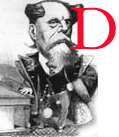 ickens's. . . early identification of the grotesque with the amusingly bizarre in Nicholas Nickleby is conventionally comic, just as his tendency to equate the grotesque with the strange in The Old Curiosity Shop is conventionally romantic. By the time of Great Expectations, however, he had expanded his notion of the grotesque as a stock property of comic convention, to a "grotesque tragic-comic conception" that, he said, inspired the novel. Significantly, Dickens applies the grotesque not to oddity of character or scene but to a conception of something inherently contradictory in the human situation, which is best brought out by the deliberate mixing of genres and types appropriate to the tragic-comic.
ickens's. . . early identification of the grotesque with the amusingly bizarre in Nicholas Nickleby is conventionally comic, just as his tendency to equate the grotesque with the strange in The Old Curiosity Shop is conventionally romantic. By the time of Great Expectations, however, he had expanded his notion of the grotesque as a stock property of comic convention, to a "grotesque tragic-comic conception" that, he said, inspired the novel. Significantly, Dickens applies the grotesque not to oddity of character or scene but to a conception of something inherently contradictory in the human situation, which is best brought out by the deliberate mixing of genres and types appropriate to the tragic-comic.
The grotesque has often been regarded as an aspect of the Romantic reaction against Neoclassicism, an attempt to summon up the demonic and Dionysian aspects of the world by reimporting the horrific and supernatural into the well-manicured world of Augustan limits. The grotesque is thus viewed as a foil to the sublime, a comic employment of the satirical as a counter to the tragic vision. Like Shakespearean comic relief or the riotous satyr plays which rounded off the trilogies of classical Greek theater, the grotesque presents an upside-down, distorted version of what has been represented in more elevated terms.
For Dickens and Carlyle, however, the grotesque, like other aspects of their style, is the organic manifestation of a profound inner vision. It was the formal literary means both of giving expression to a perception of the world as a place at once ordinary and extraordinary, ludicrous and sublime, and of unifying such contrarities through the conception of the tragicomic and the use of grotesque contrasts associated with it. [p. 190]
Related Materials
- Grotesque Symbols and Symbolical Grotesques: Carlyle
- Carlyle and Murdered Children
- Ruskin's Definition of the Grotesque
References
Goldberg, Michael. Carlyle and Dickens. Athens, Georgia: 1972.
Last modified 4 December 2004